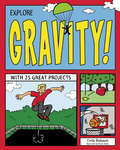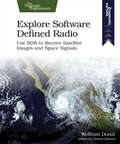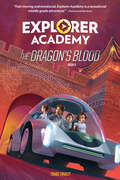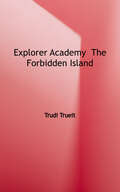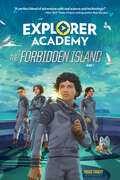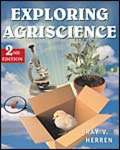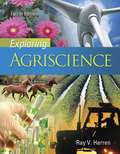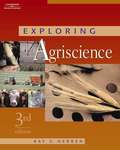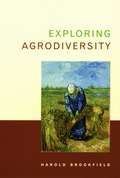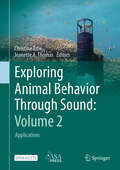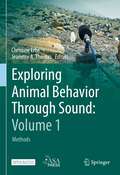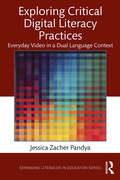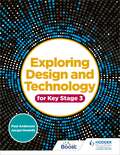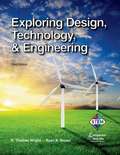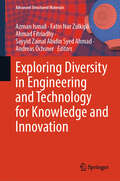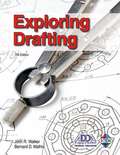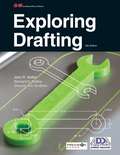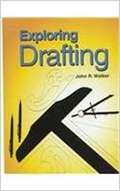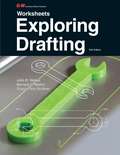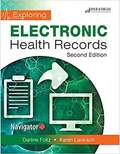- Table View
- List View
Explore Gravity!
by Bryan Stone Cindy BlobaumHow can something that grounds us and keeps us here on this earth be so invisible and mysterious? We're not talking about anything abstract and undetectable. We're talking about GRAVITY! Gravity is a force that affects everyone and everything. Gravity is something we can easily understand, even kids, especially if they have the right tools to teach them.Explore Gravity! With 25 Great Projects will introduce kids ages 6-9 to the basics of gravity, including concepts of matter, attraction, and gravitational pull. Projects include creating a working model of a scale to learn what "weight" really means and how it's affected by gravity. By playing with various weights to make a marvelous mobile, readers learn about the center of balance and how martial artists use this knowledge to throw their weight around. All the projects in this book are easy to follow, require little adult supervision, and use commonly found household products, many from the recycling box! The fun facts, trivia, jokes, comics, and hands-on activities will help kids discover the captivating science of gravity. Furthermore, the informational text and hands-on activities will excite kids about STEM, the interrelated fields of science, technology, engineering, and math.
Explore Software Defined Radio: Use Sdr To Receive Satellite Images And Space Signals
by Wolfram DonatDo you want to be able to receive satellite images using nothing but your computer, an old TV antenna, and a $20 USB stick? Now you can. At last, the technology exists to turn your computer into a super radio receiver, capable of tuning in to FM, shortwave, amateur "ham," and even satellite frequencies, around the world and above it. Listen to police, fire, and aircraft signals, both in the clear and encoded. And with the book's advanced antenna design, there's no limit to the signals you can receive. Combine your desktop or laptop computer with easy-to-find, Software Defined Radio (SDR) equipment, and tune in a wide range of signals in no time at all. Then, go one step further by converting a Raspberry Pi into your own dedicated SDR device. SDR USB dongles are usually designed to receive and decode high-definition digital television broadcasts, but the rising popularity of SDR has led to several of these devices being specifically made for - and marketed to - the software radio crowd. With step-by-step instructions, you'll have no problem getting everything up and running on both Windows and Linux. The antenna is the final piece in the SDR puzzle: Which antenna do you use? What shape do you need? How big does it have to be? And where do you point it? Get all the answers you need and learn what's possible when it comes to picking out or building an antenna. And if you're not particularly handy, don't worry. You can use an old-school set of rabbit ear antennas without too much modification. Discover the fun of this growing hobby and then open your ears to the hidden signals that surround you. What You Need: You will need a relatively recent computer or laptop, running either Windows or Ubuntu Linux. You can also use a Raspberry Pi. All of the software necessary is free and open-source, and the book describes in detail where to get it and how to install it, depending on your operating system.
Explorer Academy: The Dragon's Blood (Explorer Academy)
by Trudi TrueitAn explosive revelation and a familiar face in the sixth book in this adventure-packed series. Still reeling from the life-changing discovery he found buried in the mysterious archive, Cruz Coronado grapples with an important secret as the gang heads to China in search of the second-to-last piece of the cipher. Under the watchful eye of a new adviser, life on the ship returns to almost normal...Almost. Just as things seem to be going smoothly, a familiar face shocks Cruz back into reality, and the final piece in this life-and-death scavenger hunt veers toward a dead end. Explorer Academy features: Gripping fact-based fiction plot that inspires curiosity with new technology and innovations; Amazing inventions and gadgets; A cast of diverse, relatable characters; Secret clues, codes, and ciphers to track down within the text; Vibrant illustrations, Elements of STEAM; National Geographic explorer profiles in The Truth Behind Section. Complete your collection with: The Nebula Secret (1) The Falcon's Feather (2) The Double Helix (3) The Star Dunes (4) The Tiger's Nest (5) Explorer Academy Code-Breaking Adventure Explorer Academy Ultimate Activity Challenge Explorer Academy Field Journal Explorer Academy Future Tech
Explorer Academy: The Forbidden Island (Explorer Academy Series #7)
by Trudi TrueitAfter a near-death encounter and a disappointing message from his mother, Cruz Coronado feels as though he's running out of time to complete the cipher. Can he outsmart Nebula once and for all? Or has his journey come to a permanent end?
Explorer Academy: The Forbidden Island (Explorer Academy)
by Trudi TrueitA heart-pounding final showdown changes the life of Cruz Coronado forever in the seventh and final book in this thrilling fact-based fiction series. Amid assignments that take the Explorer Academy recruits from the iceberg-filled waters of Antarctica to the bone-dry deserts of Argentina, Cruz Coronado is scrambling to complete the last piece of the cipher. With Nebula agents and the elusive explorer spy still out there, his opportunity to recover his mother's world-changing formula is slipping away. But as Cruz has learned from his time aboard Orion, true explorers must never give up. Even after completing dozens of high-risk missions and traveling to all seven continents, Cruz could never prepare himself for one ultimate surprise. Explorer Academy features: Gripping fact-based fiction plot that inspires curiosity with new technology and innovations; amazing inventions and gadgets; a cast of diverse, relatable characters; secret clues, codes, and ciphers to track down within the text; vibrant illustrations; elements of STEAM; National Geographic explorer profiles in the "Truth Behind" section. Complete your collection with: The Nebula Secret (1) The Falcon's Feather (2) The Double Helix (3) The Star Dunes (4) The Tiger's Nest (5) The Dragon's Blood (6) Explorer Academy Codebreaking Activity Adventure Explorer Academy Ultimate Activity Challenge Explorer Academy Field Journal Explorer Academy Future Tech
Exploring Agriscience (2nd edition)
by Ray V. HerrenThis full-color exploratory approach to agriscience helps students develop a firm intellectual and skill-based foundation for further career preparations in agriscience. Its easy to follow format accommodates the middle school students need for a broad introduction to such subjects as horticulture, animal science, environmental science, biotechnology, and careers in agricultural-related fields. Numerous hands-on exercises and superb full-color illustrations help reinforce major principles, while highlighted articles, featuring FFA Career Development Events, prepare students for later participation in FFA contests. An instructor's guide, laboratory manual, teacher's resource guide and test bank CD-ROM are also available for this text.
Exploring Agriscience, 3rd Edition
by Ray V. HerrenExploring Agriscience, third edition, is a middle school text for students in Agricultural Education Programs who are enrolled in their first agriculture or agriscience class. Contents center on an exploration of agricultural industry as well as an explanation of how science concepts are used in agriculture. Topics covered include The history of agriculture; Soils, Plant structures; Entomology; Floriculture; Nursery and Landscaping; Fruit and Nuts; Row crops; Forestry; The Environment; Organic agriculture; Animal Science (including Dairy and Poultry); Aquaculture; Companion Animals; Ethics; Biotechnology; Careers; Agricultural Mechanics; Food Science; and Agricultural Education Programs. The text is illustrated with full color images that help clarify text material. Each chapter contains an insert that provides a description of an FFA Career Development Event (CDE) that relate directly to the chapter topic. Each chapter contains student learning activities that help students relate the text concepts to real life. In addition, each chapter ends with True/False, Multiple Choice and discussion questions to help evaluate student learning. An extensive teaching/learning package for the text is available. This package includes an instructor's guide, a lab model, and a classmaster CD-ROM that contains transparency masters, lesson plans, and a computerized test bank.
Exploring Agrodiversity
by Harold BrookfieldSmall farmers are often viewed as engaging in wasteful practices that wreak ecological havoc. Exploring Agrodiversity sets the record straight: Small farmers are in fact ingenious and inventive and engage in a diverse range of land-management strategies, many of them resourcefully geared toward conserving resources, especially soil. Using case studies from Africa, Asia, Latin America, and the Pacific, this book provides in-depth analysis of agricultural diversity and explores its history.
Exploring Agrodiversity (Issues, Cases, and Methods in Biodiversity Conservation)
by Harold BrookfieldSmall farmers are often viewed as engaging in wasteful practices that wreak ecological havoc. Exploring Agrodiversity sets the record straight: Small farmers are in fact ingenious and inventive and engage in a diverse range of land-management strategies, many of them resourcefully geared toward conserving resources, especially soil. They have shown considerable resilience in the face of major onslaughts against their way of life by outsiders and government.Using case studies from Africa, Asia, Latin America, and the Pacific, this book provides in-depth analysis of agricultural diversity and explores its history. The book also considers the effect of the "gene revolution" on small farmers and reviews the effects of the "green revolution" in Asian countries. In conclusion, it questions whether the diverse agricultural practices employed by small farmers can survive modern pressures and the global ambitions of the biotechnology industry.
Exploring Animal Behavior Through Sound: Applications
by Jeanette A. Thomas Christine ErbeThis open-access book offers a profound exploration of the acoustic world of animals. Organized into nine chapters by taxonomy—invertebrates, insects, amphibians, reptiles, fishes, birds, and mammals (subterranean, terrestrial, and marine)—it delves into sound production, sound reception, sound function, and the impacts of noise on these creatures. As the second volume of Exploring Animal Behavior Through Sound, it builds upon the bioacoustic concepts and methodologies established in the first volume. By attuning ourselves to the sounds of nature, we can gain valuable insights into animal behavior, distribution, and demographics, as well as their habitat characteristics and needs, and the effects of noise on their behavior. This book will serve as a valuable resource for students and researchers in animal ecology seeking to incorporate acoustics into their research toolkit, as well as for environmental managers in industry and government.
Exploring Animal Behavior Through Sound: Methods
by Jeanette A. Thomas Christine ErbeThis open-access book empowers its readers to explore the acoustic world of animals. By listening to the sounds of nature, we can study animal behavior, distribution, and demographics; their habitat characteristics and needs; and the effects of noise. Sound recording is an efficient and affordable tool, independent of daylight and weather; and recorders may be left in place for many months at a time, continuously collecting data on animals and their environment. This book builds the skills and knowledge necessary to collect and interpret acoustic data from terrestrial and marine environments. Beginning with a history of sound recording, the chapters provide an overview of off-the-shelf recording equipment and analysis tools (including automated signal detectors and statistical methods); audiometric methods; acoustic terminology, quantities, and units; sound propagation in air and under water; soundscapes of terrestrial and marine habitats; animal acoustic and vibrational communication; echolocation; and the effects of noise. This book will be useful to students and researchers of animal ecology who wish to add acoustics to their toolbox, as well as to environmental managers in industry and government.
Exploring Creation with General Science (2nd Edition)
by Jay L. WileThis course, designed to be a student's first systematic introduction to the sciences through Christian eyes, includes a history of science, the scientific method, and how to design an experiment. Subjects covered include simple machines, archaeology, geology, paleontology, biology, and human anatomy and physiology. Many hands-on experiments are included, all using basic household items.
Exploring Creativity
by Brian Moeran Bo T. ChristensenUnder the guidance of Moeran and Christensen, the authors in this volume examine evaluative practices in the creative industries by exploring the processes surrounding the conception, design, manufacture, appraisal, and use of creative goods. They describe the editorial choices made by different participants in a 'creative world', as they go about conceiving, composing or designing, performing or making, selling and assessing a range of cultural products. The study draws upon ethnographically rich case studies from companies as varied as Bang and Olufsen, Hugo Boss, and Lonely Planet, in order to reveal the broad range of factors guiding and inhibiting creative processes. Some of these constraints are material and technical; others are social or defined by aesthetic norms. The authors explore how these various constraints affect creative work, and how ultimately they contribute to the development of creativity.
Exploring Critical Digital Literacy Practices: Everyday Video in a Dual Language Context (Expanding Literacies in Education)
by Jessica Zacher PandyaIn this book, Jessica Zacher Pandya examines the everyday videomaking practices of students in a dual language, under-resourced school in order to explore the ways children interrogate their worlds, the kinds of identities they craft, and the language and literacy learning practices that emerge from digital video production. Focusing on vulnerable populations who are often left out of innovative in- and out-of-school digital media projects—including English language learners, immigrants, and children with special needs—this book offers an expanded understanding of children’s critical digital literacy practices, and shows how videomaking in the regular curriculum affords opportunities for redistributive social justice. Weaving together pedagogical, methodological, social, and political concerns into her examination of a real-world context, Pandya offers a practical and informative analysis of making videos in schools; examines the impact of videomaking on students’ language use and agency; and adds significantly to current theorizations of digital and new literacies.
Exploring Design and Technology for Key Stage 3
by Paul Anderson Jacqui HowellsDevelop knowledge, understanding and designing and making skills through Key Stage 3 so students are ready for the new GCSE in Design and Technology, with our brand-new Student Book.With topics directly linked to the new GCSE (9-1) specifications, Exploring Design and Technology will build a solid foundation by boosting your students' understanding of the key concepts, introducing them to important terminology and developing their practical skills through Key Stage 3.· Build understanding through years 7, 8 and 9 with engaging, carefully timed and level-appropriate lessons that draw on the GCSE subject content.· Develop practical skills with a variety of creative designing and making activities that use a wide range of materials, tools, equipment and processes. · Boost knowledge with clear explanations of important terminology and concepts that students will need to apply when identifying design problems, understanding user needs and developing design solutions in a range of contexts.· Encourage subject interest with 'find out more' - research features that broaden understanding of materials and their working properties, new technologies and the wider influences on designing and making.· Monitor and measure student progress with knowledge check questions provided for every topic.
Exploring Design and Technology for Key Stage 3
by Paul Anderson Jacqui HowellsDevelop knowledge, understanding and designing and making skills through Key Stage 3 so students are ready for the new GCSE in Design and Technology, with our brand-new Student Book.With topics directly linked to the new GCSE (9-1) specifications, Exploring Design and Technology will build a solid foundation by boosting your students' understanding of the key concepts, introducing them to important terminology and developing their practical skills through Key Stage 3.· Build understanding through years 7, 8 and 9 with engaging, carefully timed and level-appropriate lessons that draw on the GCSE subject content.· Develop practical skills with a variety of creative designing and making activities that use a wide range of materials, tools, equipment and processes. · Boost knowledge with clear explanations of important terminology and concepts that students will need to apply when identifying design problems, understanding user needs and developing design solutions in a range of contexts.· Encourage subject interest with 'find out more' - research features that broaden understanding of materials and their working properties, new technologies and the wider influences on designing and making.· Monitor and measure student progress with knowledge check questions provided for every topic.
Exploring Design, Technology, & Engineering
by R. Thomas Wright Ryan A. BrownExploring Design, Technology, and Engineering is an exciting introductory technology education text that provides in-depth coverage of the content defined in the Standards for Technological Literacy. Coverage includes the impacts of technology, technological systems, the history of technology,applying technology, and the designed world (agriculture and biotechnology, construction, manufacturing, information and communication, transportation, energy and power, and medical technology). This edition includes updated information o job skills, technological needs and wants, and technologicalimpacts.
Exploring Diversity in Engineering and Technology for Knowledge and Innovation (Advanced Structured Materials #215)
by Andreas Öchsner Azman Ismail Fatin Nur Zulkipli Ahmad Fitriadhy Sayyid Zainal Abidin Syed AhmadThis book offers research result which covers a wide range of topics, including sediment transportation in rivers, efficient adsorption processes, renewable energy, structural resilience, and environmental studies. Researchers explore various areas, including the stability of fishing vessels, the impact of mining on riverbeds, traditional navigation methods, medical procedures, advanced materials, and the utilization of artificial intelligence in data analysis. These comprehensive papers also address structural analysis, chloride-induced damage assessment, and the potential of soy biodiesel in marine engines. It concludes with discussions on probabilistic models, sustainable aquaculture, planning for renewable energy, and the integration of technology in environmental monitoring. This diverse compilation underscores the unwavering pursuit of knowledge and innovation across scientific and engineering disciplines, offering promise for a brighter and more technologically advanced future.
Exploring Drafting
by John R. Walker Bernard D. MathisExploring Drafting is designed for use in introductory drafting courses at any instructional level. This text provides a strong foundation in drafting fundamentals and teaches essential manual (traditional) and CAD drafting skills. Coverage includes detailed instruction on geometric constructions, orthographic projection, and dimensioning practices. The text covers techniques and procedures used in creating multiview drawings, section views, auxiliary views, pictorial views, and pattern developments. End-of-chapter drawing problems reinforce the chapter content and help students build problem-solving skills. Exploring Drafting features a colorful, highly illustrated design to promote student interest.
Exploring Drafting
by John R. Walker Bernard D. Mathis Shauna Ann ScribnerExploring Drafting is designed for use in introductory courses as it stresses fundamental skills appropriate for beginning drafting students at any instructional level and teaches both manual and CAD drafting skills. Coverage includes basic geometric constructions, orthographic projection, and dimensioning practices. Techniques and procedures used in creating Multiview drawings, sectional views, pictorial views, and pattern developments are taught. The end-of-chapter drawing problems help student build problem-solving skills and practice drafting techniques. The text follows ASME practices and serves as an ADDA approved publication.
Exploring Drafting: Fundamentals Of Drafting Technology
by John R. Walker Bernard D. MathisExploring Drafting has been extensively revised to provide improved and expanded CAD drafting content, while retaining its strong emphasis on drafting fundamentals and basic drafting techniques. It introduces the basic drawing practices and skills used by drafters. Designed for introductory drafting students at any instructional level, this textbook teaches the fundamentals used to create drawings. It shows students how to apply sketching methods, line conventions, and industry standards to solve drawing problems. The book provides instruction on geometric constructions, orthographic views, dimensioning, pictorial drawing, pattern development, and computer-aided drafting (CAD). It introduces students to common drafting tools and the basic applications of CAD. This textbook emphasizes the importance of learning basic manual skills before progressing to CAD applications. Coverage addresses the practices and techniques used in a variety of different drafting disciplines, including mechanical drafting, architectural drafting, electrical and electronics drafting, welding drafting, and graphic design. Numerous examples of drawings from industry are presented in this heavily illustrated text.
Exploring Drafting: Teaching Package Worksheets
by John R. Walker Bernard D. Mathis Shauna Ann ScribnerNIMAC-sourced textbook
Exploring Drafting: Worksheets
by John R. Walker Bernard D. Mathis Shauna Ann ScribnerThe Exploring Drafting Worksheets are designed to enrich and reinforce the material presented in the textbook Exploring Drafting. The worksheets are intended to help develop manual drafting abilities. Problems selected from the text are presented in order of increasing difficulty. Using these worksheets helps eliminate repetitive drawing, enabling you to get directly into problem-solving situations.
Exploring Electronic Health Records
by Foltz LankischUsing electronic health records accurately and effectively is critical to patient safety. This text teaches students about electronic health records across a variety of delivery systems, making it ideal for all allied health students, regardless of their career focus. To meet the needs of different types of learners, the courseware includes a wealth of images and figures; plus hands-on exercises such as interactive tutorials, assessments using a realistic EHR system, presentations, Web research, and more.
